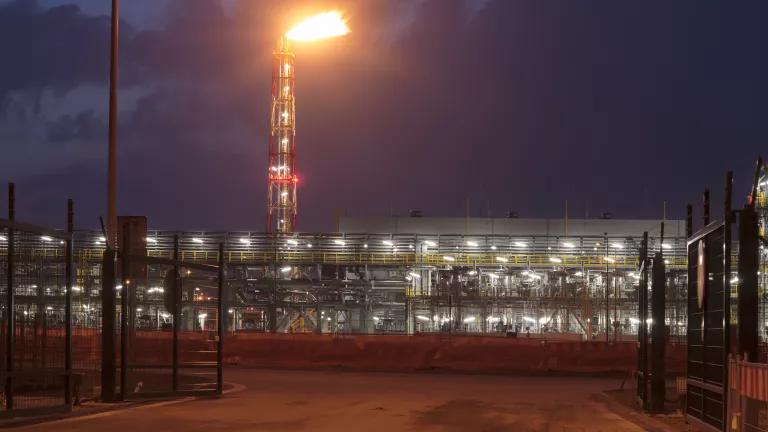Green Hydrogen: Let’s Get It Right From the Start
This year saw a slew of global hydrogen announcements that earned it the title of “hottest new tech on the decarbonization block.”
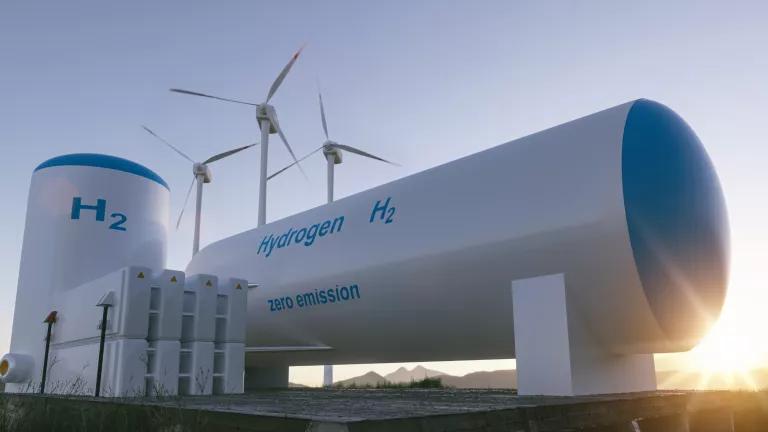
Credit: iStock/audioundwerbung
Part of NRDC's Year-End Series Reviewing 2020 Climate & Clean Energy Developments
This year saw a slew of global hydrogen announcements that earned it the title of “hottest new tech on the decarbonization block.” There is broad consensus that “green” hydrogen produced from renewable energy and water will be needed to avoid even more dangerous climate change by helping us achieve a net-zero emissions global economy by midcentury. But it has limits, despite the fossil fuel industry touting it as the one-size-fits-all solution even for applications that have much cheaper alternatives.
There’s no question that 2020 was a banner year for hydrogen. Large chunks of COVID-19 recovery packages across Europe were earmarked for the technology, more than 10 large countries put out national hydrogen roadmaps--mostly focused on green hydrogen--and large-scale projects were announced across Europe, Australia, Asia and the Middle East. While the United States is trailing behind, momentum is growing here with a series of announced green hydrogen projects, new regional hydrogen initiatives, and policy documents indicating growing interest at the federal level.
Hydrogen—mostly used in refineries and fertilizer production today—is currently produced via a dirty process that relies on fossil gas as feedstock and emits a significant amount of carbon pollution. The U.S. production of hydrogen emits nearly as much climate pollution as all of Illinois’ power plants. However, the process can be cleaned up to produce a “green” version using renewable energy and water. It also has potential replace fossil fuels in sectors most difficult to electrify such as aviation, marine shipping and heavy industry- and could help us resolve some of the biggest challenges to a fully renewable electric grid (See this blog for more detail).
With the dawn of a new year and a new administration, the 2020s offer a big opportunity for the U.S. to both join the ranks of global leaders on green hydrogen and erect the right building blocks from the outset to leverage this valuable resource without wobbling in misdirection.
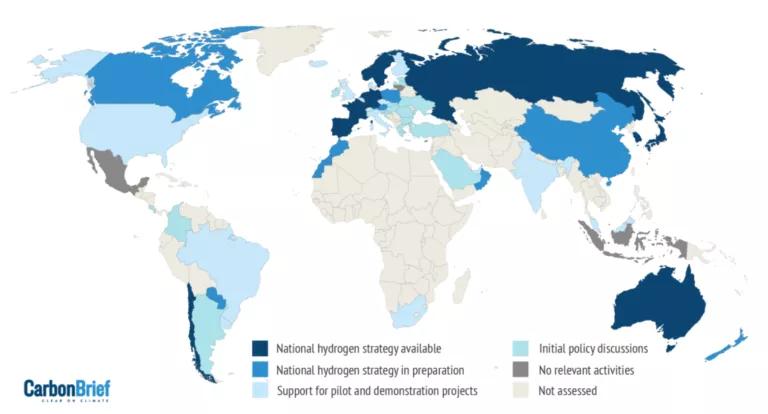
The World Energy Council’s German chapter projects that by 2025, national hydrogen strategies will likely cover countries representing over 80% of global GDP. Source: Carbon Brief, Ludwig-Bölkow-Systemtechik GmbH (LBST) and the WEC’s German Chapter
A critical component of a GHG-neutral economy, if it’s cleaned up
There is broad consensus that green hydrogen can help us meet our climate goals. But hydrogen’s ability to play a role in cleaning up the economy hinges on its own production being clean, and there’s much work to be done to get us there. Carbon-free “green hydrogen” can be produced by using renewable power to split water into hydrogen and water in electrolyzers. Green hydrogen is currently 4 to 6 times more expensive than fossil hydrogen and makes up less 1 percent of U.S. hydrogen production.
But there’s hope: this year’s global commitments are projected to significantly reduce costs and could bring green hydrogen to cost parity by as early as 2030 thanks to economies of scale and dirt-cheap renewable energy. In fact, the massive deployment targets in the European Commission’s hydrogen plan alone could drive costs of electrolyzers by 2030 to levels below those previously projected for 2050 and beyond. However, cost reductions won’t guarantee deployment. Targeted policies and robust certification schemes will be necessary to ensure that the green version is being produced and used across sectors. Those don’t exist yet, given the nascency of the space. But, as interest in new hydrogen applications grows, they should be a priority for industry, advocates, and state legislators to ensure that we’re not just shifting emissions from one point to another.
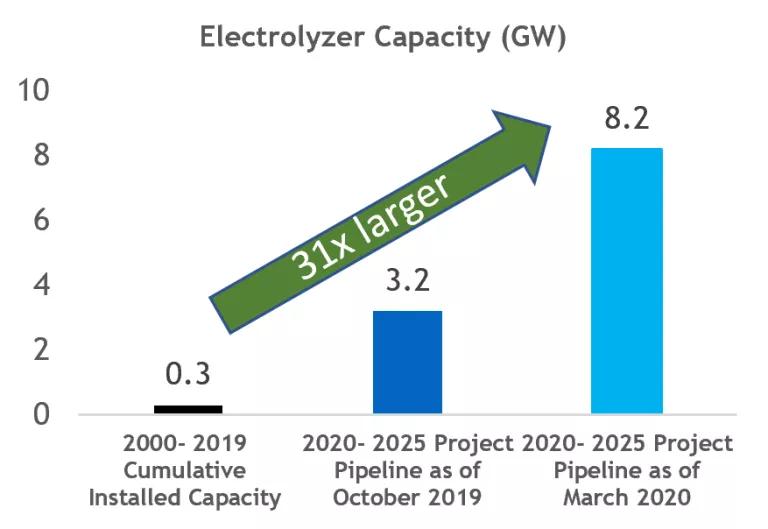
Global Announced Projects. Data Sourced from Wood MacKenzie
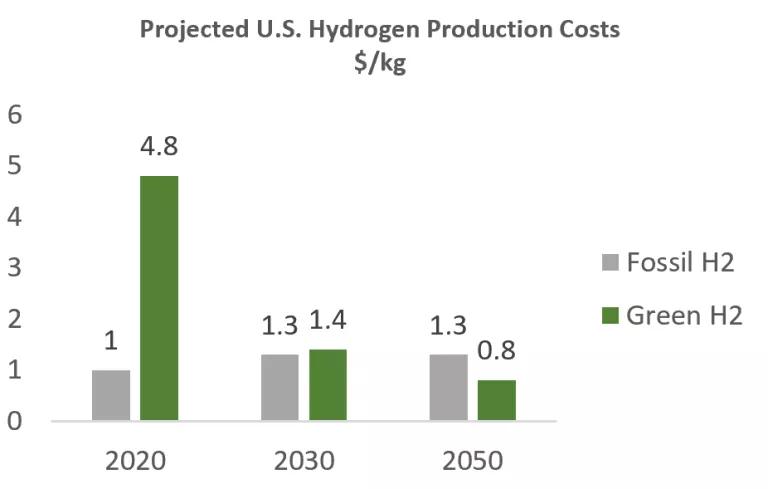
Costs for gas-based hydrogen are estimates. Source for green hydrogen production costs: Bloomberg New Energy Finance “Hydrogen Economy Outlook.”
Strong policies are needed to overcome hurdles
Despite 2020’s flurry of activity, the hydrogen era still faces significant hurdles and the technology expansion into new sectors won’t be possible without significant government support. Demand for green hydrogen is still low, costs are high, and industry is grappling with the perennial “chicken-and-egg” problem related to the necessary infrastructure buildout.
Here are our recommendations to show the long-term policy support necessary to stimulate investor appetite and de-risk the technology:
- Pass a net-zero national, economywide emissions target by midcentury;
- Set emissions standards for the trucking sector;
- Create green hydrogen hubs—i.e. clusters of geographically concentrated hydrogen users that can tap into existing hydrogen infrastructure-by supporting refineries and chemical companies in their switch from fossil to green hydrogen;
- Invest in green hydrogen demonstration projects in steel manufacturing and high-heat industries; and
- Require a low blending threshold of green hydrogen in existing gas infrastructure to jump start the market
The incoming Biden administration, which included in its climate plan a commitment to drive down the costs of green hydrogen enough to compete with the fossil version, has a pivotal role to play in implementing an effective policy package to unlock the technology potential.
Focus on the hardest to decarbonize sectors
The 2020s will also be a crucial decade to channel investments where the business and climate case for hydrogen are strongest. Those include sectors where there are few other decarbonization alternatives like aviation, marine shipping, steelmaking and long-distance trucking as well as low-hanging fruit existing applications like refineries and chemical plants.
However, some fossil fuel companies are using hydrogen as a warm futuristic mirage to prolong the status-quo, promising to convert their expanding fossil infrastructure to hydrogen sometime in the future. This is primarily playing out in the building sector, at a time when a growing number of studies show that hydrogen applications for widespread building heat are expensive use cases for the technology—and direct electrification is much more cost-effective. Therefore, a concerted regional and/or national roadmap could be critical to ensuring that hydrogen is channeled into its more valuable use cases and not used as a red herring to perpetuate reliance on fossil fuels by derailing necessary investments in the electrification of our vehicles, buildings, and industry.
This can be a decade for innovation and strong action on hydrogen where we get it right from the outset and avoid a longer fossil fuel lock-in that would be too costly to break. In other words, we’ll need to actively differentiate between “what hydrogen can do and what we should push for hydrogen to do” by directing it into the gaps in the economy, where direct electricity use isn’t feasible. The trick will be investing in green hydrogen while accelerating investments in renewable energy, efficiency, and electrification in parallel. This may not be the hydrogen economy dreamt up by boosters and industry, but “the final piece of the clean economy puzzle” is not too shabby a title.


